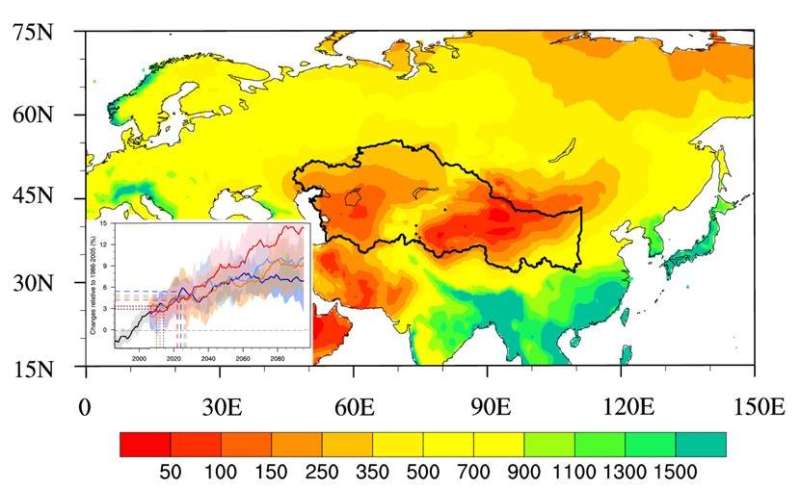Projecting climate change along the Millennium Silk Road in a warmer world

Western China and central Asia are positioned centrally along the Millennium Silk Road—a core region bridging the east and west. Understanding the potential changes in climate over this core region is important to the successful implementation of the Belt and Road Initiative, a $1 trillion regional investment in infrastructure. In a recently published study in Atmospheric and Oceanic Science Letters, scientists from the Institute of Atmospheric Physics, Chinese Academy of Sciences, projected both mean and extreme climate changes using the ensemble mean of CMIP5 models. The comparison of mean and extreme climate changes under 1.5°C and 2°C global warming scenarios highlights the impacts that can be avoided by achieving global warming of half a degree lower.
The results show a warming of about 1.5°C, 2.9°C, 3.6°C and 6.0°C under the RCP2.6, 4.5, 6.0 and 8.5 scenarios, respectively, by the end of the 21st century, with respect to the 1986-2005 baseline period. Meanwhile, the annual mean precipitation amount increases consistently across all RCPs, with an increase by about 14 percent with respect to 1986-2005 under RCP8.5. The warming over the Millennium Silk Road region reaches 1.5°C before 2020 under all the emission scenarios. The 2020s (2030s) see a 2°C warming under the RCP8.5 (RCP4.5) scenario.
"Our study suggests that half a degree less global warming will result in significant avoided impacts in the Silk Road core region," says the lead author Prof. Tianjun Zhou. According to the study, half a degree less global warming will avoid a further warming of 0.73°C (with an interquartile range of 0.49?-0.94?), as well as increasing the number of extreme heat events by 4.2 days, at a cost of a lower increase of 2.72 percent (0.47 percent-3.82 percent) in annual precipitation. The change in consecutive dry days is region-dependent.
More information: Tian-Jun ZHOU et al, When and how will the Millennium Silk Road witness 1.5 °C and 2 °C warmer worlds?, Atmospheric and Oceanic Science Letters (2018). DOI: 10.1080/16742834.2018.1440134
Provided by Chinese Academy of Sciences


















